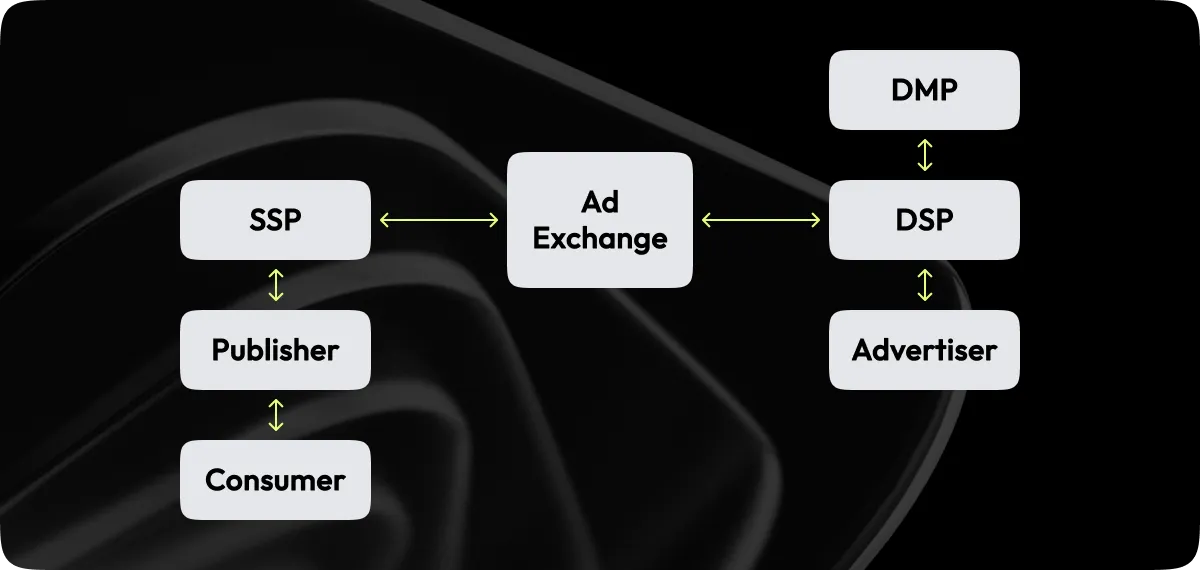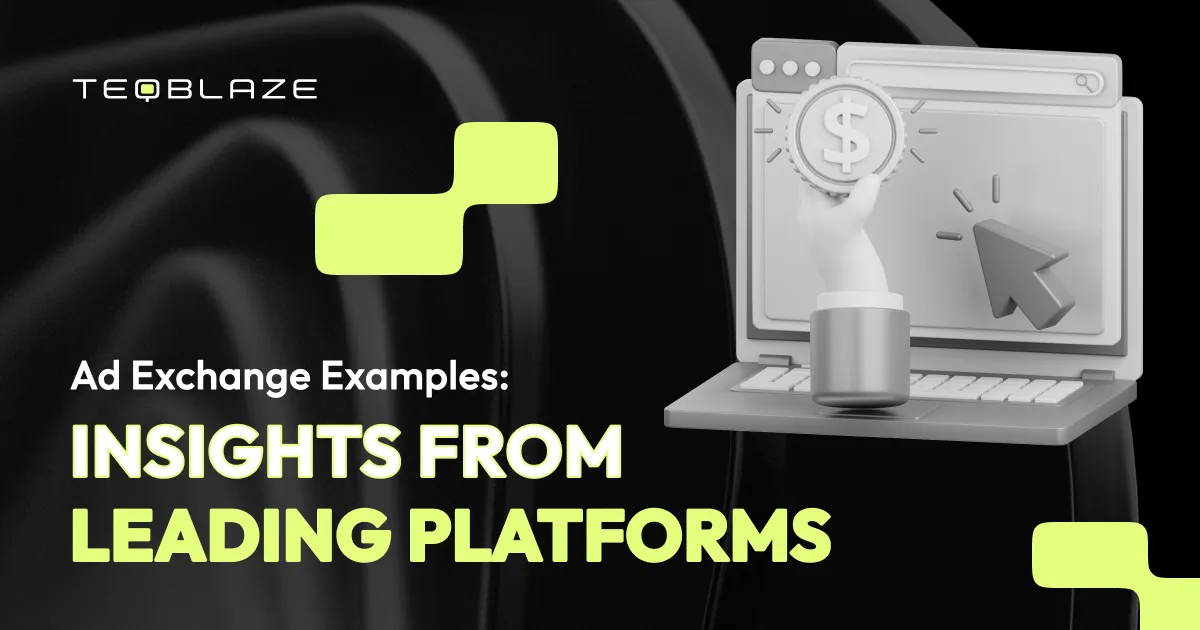Ad Exchanges were once standalone platforms. However, over the past few years, lots of companies have incorporated digital ad exchange features into their SSPs and vice versa. This allows advertisers to manage their ads and sell them via RTB on a single platform.
Next, TeqBlaze navigates through Ad Exchange, a key component of the digital advertising ecosystem, exploring its types, platforms, ad placements solutions, and future prospects.
What is an ad exchange?
Ad Exchange definition describes a platform that operates on a digital marketplace model, where publishers offer ad inventory and advertisers bid to buy it. This approach automates the purchase of ad impressions in real-time auctions, optimizing ad placements for relevancy and precise targeting.
With Advertising Exchange, publishers gain access to a huge base of advertisers who compete with each other, increasing the publisher's revenue. Advertisers, in turn, get the best ad space for their ad campaign for the fairest price.
After you have discovered what are Ad Exchanges, we can move to the practical part. So, how do Ad Exchanges work?
The publisher connects to the Ad Network and SSP for efficient monetization and automation of the ad inventory placement process.
Advertisers connect to the Ad Network and DSP to access the publisher's inventory information and participate in the auction.
A user accesses a website. As the page loads, the browser sends an Ad Request to the SSP, after which the SSP passes the request to the Advertising Exchange.
The Ad Exchange sends a Bid Request to the DSP, inviting the DSP to participate and bid for the right to display the advertisement.
The DSP compares the advertiser's demand with available display data and sends the bid to the Advertising Exchange.
The Ad Exchange collects bids from advertisers and selects the winner of the auction, then sends the data to the SSP.
The ad server receives the data from the SSP and then sends the data along with the ad to the website.

The loading of the page is complete. The user sees an advertisement that is tailored to their interests and preferences (targeted advertising).
The purchase of advertising inventory takes place in the format of an RTB (Real-Time Bidding) auction. The system determines the winner in a second based on the algorithm of the second price. Ad formats vary from classic banners to video ads.
You can find lots of types of Ad Exchange, each catering to specific needs and preferences:
Open Ad Exchange. Also known as a public marketplace or open auction, it is a digital marketplace that is accessible to anyone. The breadth of publishers on open exchanges makes them ideal for advertising seeking broad reach. On the flip side, advertisers lack specific information about publishers. Ad fraud is also a worry, given the tens of billions of impressions that pass via open ad exchanges each day. For these reasons, some advertisers prefer the protection provided by a private Ad Exchange.
Private Ad Exchange. A private marketplace is a closed, "premium" platform that allows the publisher to select which advertisers can bid, at what price, and under what terms. Each one is operated by a single publisher who personally invites specific sponsors. A private ad market enables companies and publishers to establish direct relationships with advertisers and agencies. Thus, negotiations may take longer than on an open Ad Exchange.
Preferred deal. This type enables publishers to offer digital ad inventory to specific advertisers at a predetermined price. It provides the publisher with a consistent revenue stream via a controlled transaction system, while advertisers benefit from constant CPM rates and access to exclusive content.
Mobile Ad Exchange. This type focuses on mobile advertising, allowing advertisers to buy space within apps rather than websites. Due to the extensive and particular data accessible from applications, these exchanges can provide sophisticated targeting depending on Ad Exchange app user behavior.
Leading ad exchange platforms on the market
There are numerous brand awareness campaign examples, including the following Ad Exchange companies:
Google AdX
Formerly known as DoubleClick Ad Exchange, Google AdX is an industry leader in the digital Ad Exchange space. The platform provides access to a large advertising pool via the Google Display Network (GDN). Among the key advantages, we can highlight a solid connection with other Google products, such as Google Analytics 360, and comprehensive reporting and data insights.
Xandr
Previously known as AppNexus, the platform offers publishers and advertisers an independent, transparent alternative to Google AdX with a robust platform. Strong header bidding solutions with an emphasis on transparency are perfect for publishers who are looking for greater control over their ad inventory. The key features include programmatic direct deals, powerful targeting capabilities, and unrestricted access to a large variety of DSPs.
Magnite
The former Rubicon Project and SpotX platform combine the resources of two market leaders, providing publishers with a complete solution for all platforms. These include online, mobile, and OTT (over-the-top) TV. Magnite offers wide platform reach, a strong emphasis on video advertising, and is ideal for publishers with a variety of ad inventory.
OpenX
OpenX is a well-known independent digital Ad Exchange that prioritizes publisher-centric solutions and innovation. It proposes a clear pricing structure and places a strong emphasis on publisher needs. The platform also boasts unrestricted access to a large variety of DSPs. Publishers can effortlessly incorporate header bidding into their websites with OpenX Prebid.js.
PubMatic
An international company that specializes in omnichannel and mobile advertising solutions. The essentials feature support for numerous ad formats, including rich media and video, private marketplaces, and server-side bidding (SSB) capabilities, with an emphasis on optimizing publisher revenue.
SmartyAds
Well-known for emphasizing rich media and video ad formats, SmartyAds is a good option for publishers looking to use cutting-edge creative alternatives. The platform offers a DSP and an SSP as part of its full-stack programmatic infrastructure, which gives publishers and advertisers a complete solution.
Smaato
Smaato is a worldwide mobile Ad Exchange that is especially beneficial to publishers and developers of mobile apps because of its robust presence in growing regions. The platform’s features and functionalities are designed exclusively for mobile app monetization. This includes real-time statistics to improve ad campaigns, and mediation tools to link with various ad networks and in-app ad formats.
Key features to compare
Real-time bidding (RTB) capabilities are supported by every platform in the Ad Exchange list, guaranteeing publishers quick advertisement placement and maximum profit.
Data integration and targeting increase the relevance and effectiveness of advertising. In this regard, Google AdX excels since it provides a smooth interaction with other Google products, enabling precise audience targeting. On the other hand, Xandr adopts a more transparent strategy, letting publishers combine data from multiple sources thanks to its connections to a variety of DSPs. Magnite provides data-driven targeting solutions for OTT and mobile audiences, with a focus on video advertising. Publishers with web and mobile audiences can benefit from granular targeting made possible by OpenX and PubMatic, which also prioritize data integration.
Transparency and fraud prevention are both crucial factors. Xandr is distinguished by its emphasis on impartiality and openness, offering comprehensive data and strong anti-fraud safeguards. OpenX is renowned for its publisher-centric strategy, transparent pricing structures, and anti-fraud technologies. To ensure transparency and fight fraud, PubMatic and Google AdX offer analytics and reporting tools. Magnite, on the other hand, specializes in fraud detection for video advertising.
The top ad exchanges that provide the most ad format support are Google AdX and Magnite. The formats include rich media, display, video, and native advertising. SmartyAds sets itself apart with its expertise in rich media and video ad formats that draw viewers in and increase revenue. Smaato also specializes in mobile ad formats and meets the demands of publishers and developers of mobile apps. This translates to features and functionalities made especially for mobile apps, assisting publishers and developers in making the most money from their advertising.
Industry trends and future outlook
With constant changes in regulations, the rise of new technology, and consumer behavior switches, being aware of industry trends is a must. Here is a future outlook on some of the most promising programmatic examples:
Programmatic Ad Exchange growth
The amazing growth of programmatic advertising is related to the rise of Ad Exchanges. By automating the process of buying ad inventory, programmatic increases productivity, efficiency, and targeting options, matching publishers with the relevant advertisers at the appropriate moment.
AI and Machine Learning
AI makes it possible to analyze enormous amounts of data in real time, which facilitates quicker and more accurate campaign optimization. At the same time, Machine Learning capabilities also help predict campaign success and detect fraudulent behavior. The role of machine learning in advertising is becoming increasingly critical, enabling advertisers to refine targeting, optimize bidding strategies, and personalize ad experiences at scale. By leveraging predictive analytics, advertisers can enhance performance while minimizing wasted ad spend.
Privacy and regulation
Ad Exchanges leverage users to display relevant ads in front of the right audiences. However, it is becoming increasingly harder to collect, with Google preparing to ditch third-party cookies and Apple now requesting user permission to expose device IDs. To comply, consider data privacy laws like the CCPA and GDPR for greater transparency and user control.
Video advertising
The demand for video advertising is projected to rise. To meet this increase, Ad Exchanges need to provide robust video ad formats, quick bidding solutions for video inventory, and advanced campaign measurement capabilities.
Multiple channels
Modern consumers switch between platforms and devices with ease. This is why a multi-channel advertising strategy is crucial for handling campaigns and acquiring ads seamlessly across online, mobile, and OTT (over-the-top) TV.
Blockchain
While still in its early stages of implementation, blockchain technology has the potential to transform how an Ad Exchange works by increasing transparency, security, and efficiency. Blockchain can be used to provide a tamper-proof record of ad transactions, decrease fraud, and give customers greater control over their data.
How does TeqBlaze expertise benefit AdTech
TeqBlaze has positioned itself as an expert with a focus on programmatic advertising solutions. Designed to meet any of your business needs, TeqBlaze offers a complex platform following all the trends in the market. Considering the latest regulations, the customer’s data is not shared with anyone else and is located on separate servers.
With solid expertise that exceeds 13 years in developing real-time bidding platforms and programmatic advertising, we help our clients reduce reliance on third-party platforms. Such a break free from third-party advertising gives them complete freedom and independence over their ad operations. By providing a powerful, adaptable white-label SSP+Ad Exchange technology, TeqBlaze allows publishers to quickly onboard demand sources and integrate publishers opening new ways to increase their advertising revenue. It’s time to unlock your programmatic potential l and TeqBlaze knows exactly how to expand your capabilities in this dynamic AdTech ecosystem.

 Anna Vintsevska
Anna Vintsevska





